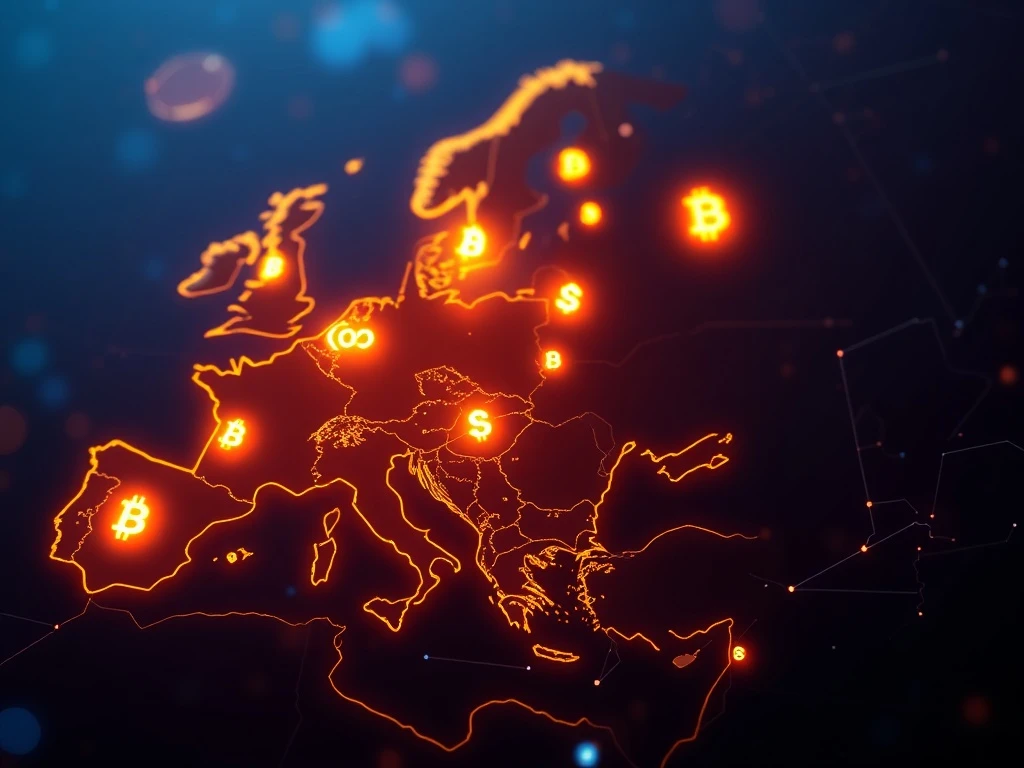Russia Crypto Adoption Unveils Remarkable Surge, Tops Europe According to Chainalysis

A surprising revelation has captured the attention of the cryptocurrency world: Russia crypto adoption now ranks highest in Europe. This significant finding comes from the latest Chainalysis report, which meticulously analyzes crypto activity across the continent. The report highlights Russia’s rapid growth in decentralized finance (DeFi) and a notable increase in large-value transfers, indicating a profound shift in how the nation engages with digital assets.
Unpacking Russia’s Dominance in Crypto Adoption
Crypto adoption in European countries like the United Kingdom and Germany lags behind Russia, according to the US blockchain analytics firm Chainalysis. Russia emerged as the leading crypto market in Chainalysis’ latest European Crypto Adoption report. It received an impressive $376.3 billion in crypto between July 2024 and June 2025. Published recently, the report combines analyses of regions previously examined separately. It now covers Central, Northern, and Western Europe, as well as Eastern Europe as a whole. Chainalysis explained, “For this year’s analysis, we’ve reorganized our regional classifications to better reflect both current crypto activity and geopolitical realities.” This new classification provides a clearer picture of regional dynamics.
Russia’s received crypto volumes have increased by 48% from last year’s $256.5 billion. This widened its lead over major economies. For example, the UK recorded $273.2 billion in the past year, approximately 30% less than Russia. Chainalysis attributed Russia’s surge in crypto adoption to two primary factors:
- A significant spike in large institutional transfers.
- The growing use of decentralized finance (DeFi).
These drivers illustrate a maturing crypto landscape within Russia. They point to broader integration into financial services.
The Surge in Institutional Crypto Transfers
The scale of institutional activity is particularly notable, according to the Chainalysis report. It refers to large transfers, specifically those exceeding $10 million. These transactions surged by an impressive 86% year-over-year (YoY). This surge pace is nearly double the 44% growth observed in the rest of Europe. Such a dramatic increase in institutional crypto transfers suggests growing confidence among major players. These entities likely leverage digital assets for various financial operations. Furthermore, this trend highlights a strategic shift towards crypto as a legitimate tool for large-scale transactions. Businesses and high-net-worth individuals increasingly utilize cryptocurrencies. This facilitates efficient and often discreet financial movements. This growth underscores the evolving role of digital assets in global finance, even in challenging regulatory environments.
Russia’s Explosive DeFi Expansion
Beyond institutional activity, Russia also leads in both large and small retail segments. Its YoY growth outpaces the rest of Europe by about 10%. “DeFi adoption patterns reveal an even more dramatic shift,” Chainalysis stated. Russia’s DeFi expansion saw activity surging eight times its previous levels in early 2025. This exponential growth in decentralized finance signifies a profound transformation. It allows individuals and businesses to access financial services without traditional intermediaries. DeFi offers new avenues for lending, borrowing, and trading. This appeals to a population seeking alternative financial solutions. The rapid embrace of DeFi platforms points to a strong desire for financial autonomy and innovation. Consequently, Russia’s digital economy gains significant momentum through these decentralized protocols.
A7A5 Stablecoin: A Key Player Amidst Sanctions
Russia’s rapid DeFi expansion and the increase in large-value transfers indicate growing adoption of crypto for financial services. Chainalysis concluded this point definitively. It also mentioned A7A5 stablecoin as a major example of this trend. This sanctioned ruble-pegged stablecoin, issued in Kyrgyzstan, facilitates cross-border payments. It serves both institutional and business users effectively. Launched in early 2025, A7A5 has emerged as the world’s largest non-US dollar stablecoin by market capitalization. This occurred despite facing multiple sanctions. The European Union has criticized the stablecoin. They allege its use as a tool for sanction evasion by Russia. The US government has also linked A7A5 to Grinex. Grinex is the successor of Garantex. Garantex was allegedly involved in money laundering and ransomware attacks. It processed $100 million in transactions related to illicit activities. The ruble-pegged stablecoin reached $500 million in market cap in late September. It overtook major non–US dollar rivals, such as Europe’s euro-pegged EURC, issued by Circle. This highlights its significant, albeit controversial, impact on the market.
Navigating Geopolitical Realities and Regulatory Scrutiny
Chainalysis’s findings on Russia’s crypto market growth over the past year come amid mounting sanctions and an intensifying regulatory focus in the region. These geopolitical realities shape the operational environment for crypto. The increased adoption occurs despite, and perhaps partly because of, these pressures. Notably, Russia was excluded from the Financial Stability Board’s peer review on cross-border regulation. This exclusion was also published on Thursday. This action underscores the international community’s concerns. It also reflects the complex interplay between national policies and global financial systems. The continued growth of Russia crypto adoption in this context suggests resilience. It also points to the innovative ways users find to engage with digital assets. Therefore, understanding these dynamics becomes crucial for global financial stability. The interplay between sanctions, regulation, and technological adoption creates a unique landscape.
Conclusion: Russia’s Enduring Crypto Trajectory
The latest Chainalysis report offers invaluable insights into Russia’s evolving crypto landscape. Its leading position in European crypto adoption is undeniable. This dominance stems from robust DeFi expansion and substantial institutional crypto transfers. The rise of the A7A5 stablecoin further exemplifies Russia’s unique approach to digital asset utilization. Despite facing significant international sanctions and regulatory scrutiny, the nation’s crypto market demonstrates remarkable growth and adaptability. These trends underscore the complex relationship between geopolitical forces and the burgeoning world of decentralized finance. As global financial systems continue to evolve, Russia’s trajectory in crypto adoption will undoubtedly remain a focal point for analysis and discussion.









